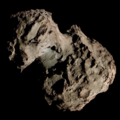 Comet 427P/ATLAS photographed from the WIYN Observatory (left) and the Hubble Space Telescope (right). [1] | |
| Discovery [2] | |
|---|---|
| Discovered by | Aren Heinze |
| Discovery site | ATLAS–HKO (T05) |
| Discovery date | 27 September 2017 |
| Designations | |
| P/2017 S5, P/2021 L6 | |
| Orbital characteristics [3] [4] | |
| Epoch | 23 November 2017 (JD 2458080.5) |
| Observation arc | 3.89 years |
| Earliest precovery date | 11 September 2017 |
| Number of observations | 438 |
| Aphelion | 4.163 AU |
| Perihelion | 2.178 AU |
| Semi-major axis | 3.171 AU |
| Eccentricity | 0.31304 |
| Orbital period | 5.646 years |
| Inclination | 11.849° |
| 252.39° | |
| Argument of periapsis | 99.944° |
| Mean anomaly | 20.594° |
| Last perihelion | 19 March 2023 [5] |
| Next perihelion | 31 October 2028 [5] |
| TJupiter | 3.092 |
| Earth MOID | 1.210 AU |
| Jupiter MOID | 1.664 AU |
| Physical characteristics [6] [7] | |
Mean radius | 0.45 ± 0.06 km (0.280 ± 0.037 mi) |
| ~1.4 hours | |
| 0.06±0.02 | |
| (V–R) = 0.43±0.05 | |
| Comet total magnitude (M1) | 10.7 |
| Comet nuclear magnitude (M2) | 15.8 |
427P/ATLAS is a periodic comet and an active asteroid with a 5.65-year orbit around the Sun. It is the second comet discovered by the Asteroid Terrestrial-impact Last Alert System after 478P/ATLAS. [8]

